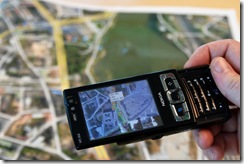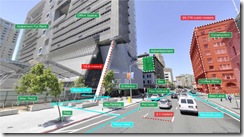Mobile augmented reality allows computer-generated content to be superimposed over a live camera view of the world. The technology and its applications have been under development for a number of years, though it is in 2010 and that more applications are expected to proliferate on mobile devices, and monetisation of such services is expected to gain traction
Juniper Research says revenues from augmented reality are unlikely to exceed US$2 million in 2010, due to there being only a small minority of smartphones that are AR-enabled
A report published by Juniper Research late last year forecast that the market for mobile augmented reality (AR) services would reach US$732 million by 2014, with revenues derived from a combination of paid-for app downloads, subscription based services and advertising.
The research firm found that annual revenues from AR are unlikely to exceed even US$2 million during 2010, due to the fact that only a small minority of smartphones will be AR-enabled. However, it is forecast that this proportion will rise dramatically in the medium-term, the result of increasing adoption of Android handsets and iPhones, along with greater deployment of AR enablers such as digital compasses and accelerometers by other leading vendors.
Although initial service adoption will be driven by AR location-based search, Juniper Research expects the first substantial revenues to be derived from AR-enabled games, bolstered by revenues from mobile enterprise solutions from 2012/3 onwards.
Meanwhile, AR advertising is expected to be increasingly attractive to brands and retailers as the potential user base increases, with AR ad networks able to charge higher cost-per-click (CPC) and cost-per-thousand impressions (CPM) rates because of location relevance.
However, the report cautioned that while AR geotagging presents a wealth of opportunities, providers and enablers must carefully consider the potential legal implications of enabling such services.
According to Jay Wright, director of business development at Qualcomm, there have been two main approaches to mobile AR thus far, each with a different technological focus but a similar aim of achieving tight visual registration. The first approach involves first-generation mapping solutions, incorporating compass and global positioning systems.
While this first approach to mobile AR has helped drive the development of location-relevant information becoming available, it has not typically had the type of accuracy necessary to render very specific points of interest on the mobile device’s screen.
Thus a second approach to developing AR applications has begun to gain traction and is related to vision-based technology.
“Vision-based AR is much more difficult to achieve,” says Wright. “The device requires a camera operating at 30 frames per second and computationally it is very difficult.” However the benefits of vision-based AR become easily apparent when it comes to running applications that include gaming, interactive media, and instructional and educational applications.
“AR is like playing a video while at the same time utilising 3D gaming; it is very power hungry and uses a lot of battery to keep running,” Wright comments.
Qualcomm’s Jay Wright believes augmented reality is helping transform mobile devices into the remote controls of peoples’ lives
Qualcomm has invested over two years of R&D into AR, and in other parts of the world the technology’s potential is already starting to be harnessed. In Japan, that hotbed of mobile technology, the country’s two largest mobile operators are beginning to offer their subscribers AR interfaces over smartphones, which come complete with vast online databases of information.
NTT DoCoMo launched “chokkan nabi”, or “intuitive navigation”, in September to help people find their way around Tokyo and Osaka and other places in Japan.
“You just need to focus on a street, a building or a particular spot with your camera-equipped mobile phone to see if there is a bank, a restaurant, a supermarket or other location,” said a DoCoMo official.
“Labels or signs indicate, for example, the distance to a chosen restaurant, schedules, menus, etc … With a simple gesture, you can switch back to a conventional map in two dimensions.”
The service registered around 600,000 points of interest throughout Japan at the time of introduction, including restaurants, shops and train stations, which can be searched through user-defined criteria.
The technology, developed with map maker Zenrin, uses a global positioning system (GPS) and sophisticated software to place virtual tags on real-world objects and also provide directions to places outside the user’s direct view.
It also links with micro-blogging site Twitter so that its users can spot each other in real time and real space, and tweet comments about where they are.
Japan’s number two mobile operator KDDI, meanwhile, has developed a platform that allows users to scan for example a CD advertising poster with their camera phone to gain additional material, such as an extract from a song.
The service will then offer the user the option to buy a download of the song with just two clicks, or can guide them to the nearest real-world CD shop.
The application, which also features virtual characters, is an advanced version of an already popular Japanese application for Apple’s iPhone, called “Sekai Camera” or “World Camera”.
That programme identifies visual landmarks and then displays live and past tweets from others as “air tags” in the same location. Internationally, several operators are harnessing similar technology.
Applications such as gaming, interactive media, and instructional and educational services are expected to drive demand for augmented reality
Nokia is offering a free application called Point & Find, which involves pointing your camera phone at real-world objects to access information and functions.
The service also allows users to scan barcodes to compare prices, read reviews, or save a product to a wish-list.
A start-up application provider developed in collaboration with Alcatel-Lucent’s incubator investment programme is Dekaps, an AR developer offering information associated with an image taken by a smartphone’s camera. Dekaps is available on Apple apps and as with other augmented reality systems, can provide not only location-based information but also a virtual layer of information based on the recognition of an image.
Dekaps can propose augmented reality through geo-localisation, but can do more with image recognition and 2D code recognitions.
“Qualcomm is following a vision of the mobile device becoming the remote control of a person’s life,” Wright comments, and he believes the business models that have already been established in the telecom sector to deal with the entry of content providers will continue to adapt with respect to AR.
“The revenue share models in place are not going to change,” he says. “AR is just a new technology but in terms of the business model, that will remain pretty much the same,” he added.





0 comments ↓
There are no comments yet...Kick things off by filling out the form below.
Leave a Comment